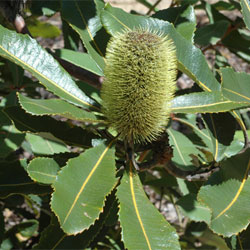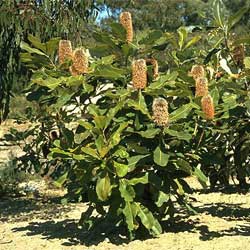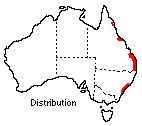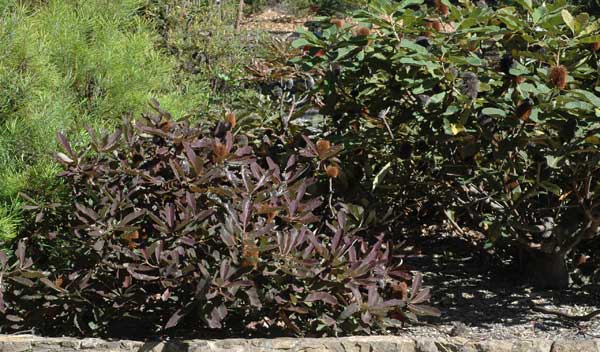Banksia robur
 |
 |
Swamp Banksia
Banksia robur, the Swamp Banksia, occurs in swamps along the coast and nearby plateaus of New South Wales and Queensland from the Illawarra district in the south to Gladstone in the north.
 In
most parts of its range it is rarely taller than 1-2 m but in cultivation it
readily reaches 2 m or more with a spread of at least 2 m.
In
most parts of its range it is rarely taller than 1-2 m but in cultivation it
readily reaches 2 m or more with a spread of at least 2 m.
Despite its natural occurrence in wet places it is a most adaptable plant in the garden and will thrive in a great variety of soils and situations. It is ideal for the damp corner but providing adequate watering is available it will tolerate a much drier site. Full sun is required for good flowering.
B. robur is a dramatic shrub. Its very large, stiff serrated leaves may reach 40 cm long by 12 cm wide. They are a mid-green above with a pale, flannel-like under-surface which contrasts with the feather-like yellow-brown veining of the older leaves. The yellow mid-vein is also obvious on the upper surface. In the young growth a rusty-brown tomentum (a fur-like covering) clothes these veins and new stems.
The open habit of the shrub and the heavy leaf structure give the plant a bold outline which may be incorporated as a feature in a home landscape or as a group planting in an urban park situation.
The flower spikes appear usually in autumn and winter but odd flowers may appear in other seasons. When in bud, they appear as a bluish green but turn yellow-green as the flowers open. The flowers darken on further ageing and persist after drying for many months, sometimes years. Flower spikes may be borne terminally or along the older stems from ground level and in many cases multiple spikes occur. The spent flowers, many bearing fruit, form an interesting feature of the shrub.
In the Australian National Botanic Gardens the species has proved hardy to frosts in open situations after the first year but may require covering for the first winter if growth is soft. It grows quickly, reaching 1.5 m in three years and bearing its first flowers at that time.
There appears to be two distinct forms growing in the Australian National Botanic Gardens, one with dark purple-green foliage (left in photo below) and a more upright plant with bright green foliage (right).

It seems to be generally resistant to root-rot fungus, although this fungus has been isolated from one specimen in the Gardens. Apart from occasional chewing insects the plant appears to be pest free. Pruning may be carried out after flowering if a more branched, tighter shape is required.
Propagation is from seed which germinates readily in three to five weeks. Seedlings should be pricked out at the cotyledon stage and grown on in a well-drained potting mix prior to planting.
Text byANBG staff (1976)
Name meaning: Banksia roburBanksia - after Sir Joseph Banks, the British scientist who travelled with Captain James Cook; robur - strength, probably referring to the robust nature of
the plant. |
![An Australian Government Initiative [logo]](/images/austgovt_brown_90px.gif)

